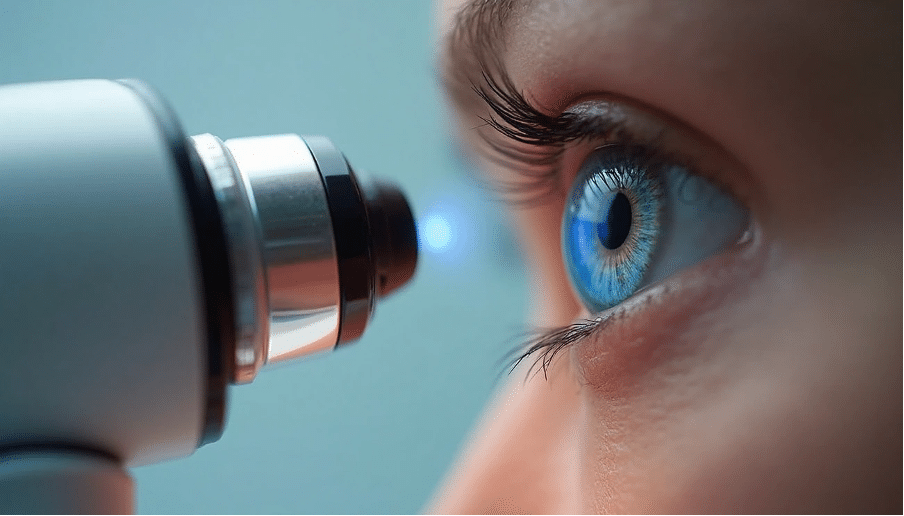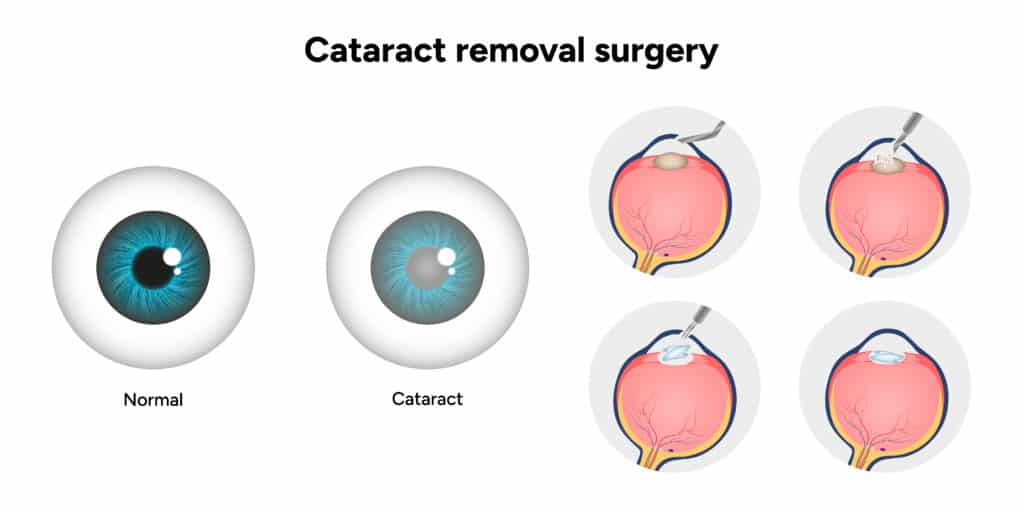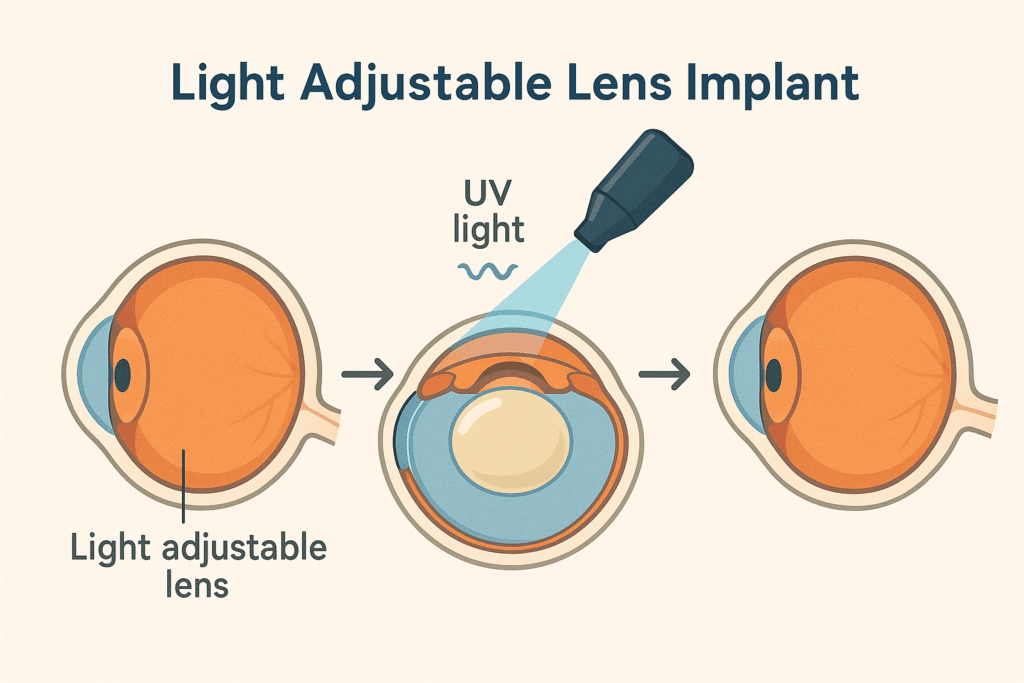Traditional fixed-power lenses in cataract surgeries hit their vision targets only 70-75% of the time. Light-Adjustable Lens Implants are transforming these numbers significantly.
Clinical studies reveal impressive results. Patients with Light Adjustable Lenses achieved 20/25 vision or better 92% of the time. Standard fixed lens implants reached this mark just 60.6% of the time. These remarkable results stem from a groundbreaking feature – Light Adjustable Lens stands as the first FDA-approved intraocular lens (IOL) with adjustable power after surgery.
Light adjustable lens brings a revolutionary approach to vision correction. Your surgeon can fine-tune your vision several weeks after your cataract surgery. The adjustment takes minimal time – 30 seconds to 2 minutes. It corrects astigmatism even at levels as low as 0.50 diopters. Patients who choose these adjustable IOLs see better results. They have higher chances of achieving 20/20 vision and need glasses less often.
This piece offers a detailed look at Light-Adjustable Lens implants. You’ll learn how they work, what recovery involves, and how customisation happens. If you’re thinking over cataract surgery or learning about options for clearer vision, this innovative technology could be your path to freedom from glasses.

What Is a Light Adjustable Lens Implant?
The Light Adjustable Lens (LAL) stands out as one of the most important breakthroughs in cataract surgery technology. This lens is unique among all intraocular lenses because doctors can customise your vision after your cataract surgery. The lens contains special photosensitive materials that doctors can adjust precisely after implantation. This gives them unprecedented control over your visual outcome.
How it is different from traditional IOLs
Traditional intraocular lenses come with fixed prescriptions that stay permanent after implantation. Your surgeon must choose the lens power before surgery based on measurements and calculations. These lenses leave no chance for adjustments later. If your vision isn’t perfect after surgery with traditional IOLs, you’ll need glasses, contact lenses, or extra procedures like LASIK.
Light Adjustable Lens implants are different because they:
- Use special photosensitive material (macromers) that react to ultraviolet light
- Let doctors adjust power without surgery weeks after the procedure
- Can be customised based on your real-life visual experience instead of calculations
- Fix astigmatism, nearsightedness, and farsightedness with excellent precision
These adjustable lenses are a great way to get better results, especially when you have previous eye surgeries like LASIK or radial keratotomy (RK), or unusual cornea shapes. Studies show impressive outcomes – 91.6% of patients get 20/25 vision without needing glasses.
Why adjustability matters in cataract surgery
Modern surgical techniques have improved, but traditional cataract surgery still faces some challenges. Research shows that all but one of these eyes achieve within 0.5 D sphere of the intended target with standard IOLs. This happens because everyone heals differently, has unique eye anatomy, and responds to surgery in their own way.

Knowing how to adjust lens power after surgery changes everything. You can work with your surgeon to fine-tune your vision based on your actual experience about three weeks after LAL implantation. You’ll need 2-4 light treatments that take around 90 seconds each. This process gives you a chance to “test drive” your vision before making final decisions. You can try different scenarios – reading small text or night driving – and tell your surgeon what works best for your daily life.
The numbers tell the story: 92% of patients end up within 0.5 D of their target vision, and 99.5% come within 1 D after adjustments. For astigmatism correction, 82% of patients have no more than 0.5 D astigmatism six months later. Light Adjustable Lenses change cataract surgery from a procedure with predictable outcomes to personalised vision care. You become an active participant in designing your vision based on your unique needs and priorities.
Your surgeon performs “lock-in” treatments to set the lens power permanently once you’re happy with your vision. This innovative approach to vision correction marks a major step forward in modern eye care. You get more control over your visual outcome and might need fewer glasses or contacts afterward.
How Light Adjustable Lens Technology Works
A groundbreaking advancement in Light Adjustable Lens implants came from Dr. Danial Schwartz of the University of California and Chemistry Professor Robert Grubbs from the California Institute of Technology in 1997. Their innovative work led to a lens that doctors could modify after implantation, which changed the outcomes of cataract surgery.
Photosensitive macromers and UV light
The technology relies on a special photosensitive silicone material with molecules called macromers. These macromers spread evenly through the lens matrix and react to ultraviolet light. UV light (365 nm wavelength) activates the macromers in specific areas, which then polymerise by joining with other macromers to create longer chains.
This selective polymerisation creates different concentrations between treated and untreated parts of the lens. The unexposed macromers naturally move into treated areas over about 12 hours until they balance out. This molecular movement predictably changes the lens curvature and refractive power. The brilliance of this method lets surgeons make both spherical and cylindrical adjustments with great precision. They can achieve “corrections ranging from -2D to +2D sphere and -0.5D to -3.0D cylinder“.
The role of the Light Delivery Device (LDD)
The Light Delivery Device delivers precise UV light treatments to the implanted lens. This advanced tool combines an anterior segment biomicroscope, optical projection system, electronic controls, and a UV light source. Patients sit in front of the LDD while it projects a specific light pattern onto their implanted lens. The doctor centres and focuses the treatment beam as patients look at a fixed target. This non-invasive process usually takes “between 40-120 seconds (averaging 90 seconds) per treatment”.
The LDD fixes various vision problems by targeting specific lens areas:
- Central irradiation adjusts for farsightedness
- Peripheral irradiation addresses nearsightedness
- Custom patterns correct astigmatism
Understanding the adjustment and lock-in process
Customisation starts 2-4 weeks after surgery when the eye heals. The doctor performs a detailed refraction to assess visual needs. The doctor creates a custom prescription based on refraction and lifestyle needs before starting adjustments. Patients typically need 2 to 4 light treatments, spaced about 3 days apart. Special UV-protective glasses must be worn during waking hours to prevent unwanted changes from ambient UV light.
Patients play an active role in designing their vision. They can test their new vision in real-life situations after each adjustment and decide if they need more refinements. A final “lock-in” treatment sets the lens power permanently once the patient and doctor are happy with the results. This process uses UV light on the entire lens to use up all remaining photosensitive macromers. Patients can stop wearing protective glasses after the lock-in since their customised vision correction becomes permanent.

Who Can Benefit from Light Adjustable Lenses
You might wonder if light-adjustable lens implants will work for your vision correction needs. Most cataract patients can benefit from these customisable lenses, though they aren’t right for everyone.
Ideal candidates for adjustable IOLs
Light Adjustable Lens implants work best for cataract patients who don’t have other serious eye conditions. The best candidates are people who:
- Want to be free from glasses after cataract surgery
- Have at least 0.75 diopters of astigmatism
- Can make it to several follow-up appointments
- Don’t mind wearing UV-protective eyewear during adjustments
Light-adjustable lens implants are changing how we approach vision correction. Your surgeon can fine-tune your eyesight after surgery with this innovative technology. This gives you better control over your final vision—making it perfect if you want precision without compromise.
Contraindications and limitations
Some factors might rule out Light Adjustable Lens implants as an option. These include: If you have medications that increase UV light sensitivity, you should avoid LAL treatments. Medications like tetracycline, doxycycline, psoralens, amiodarone, phenothiazines, and chloroquine could cause permanent phototoxic eye damage. Patients on retina-toxic medications like tamoxifen also face higher risks during adjustments.
The treatment isn’t suitable if you have ocular herpes simplex virus because UV exposure might reactivate it. Nystagmus (uncontrolled eye movements) or pupils that don’t dilate enough for proper lens adjustment are also disqualifying factors.
Special considerations for post-LASIK or diabetic patients
Patients who’ve had laser vision correction are among the best candidates for Light Adjustable Lens implants. Traditional IOLs work well for only 60-70% of post-LASIK, PRK, or RK patients, achieving accuracy within ±0.50D. LAL does much better, reaching this accuracy in 97% of post-refractive surgery eyes.
Light Adjustable Lenses are a great option if you have diabetes. Diabetic patients often have unpredictable healing patterns, so being able to adjust after surgery provides extra safety and personalisation. This flexibility helps manage the changing eye conditions common with diabetes.
These lenses are also ideal if you have irregular corneas, high degrees of nearsightedness or farsightedness, or have worn rigid contact lenses. The ability to customise vision after surgery helps in challenging cases where standard lens measurements don’t work well enough.
The Customisation Journey After Surgery
The customisation of your Light Adjustable Lens implants begins right after your cataract surgery. Standard cataract surgery becomes a personalised visual experience through this process.
Timeline of adjustments and lock-ins
Your vision needs to stabilise before starting the customisation process, which takes several weeks after surgery. Your surgeon will check your healing progress to determine the best time to start adjustments. The complete timeline has:
- First adjustment: 2-3 weeks post-surgery
- Additional adjustments: Weekly intervals based on your surgeon’s assessment
- Possible adjustments: Up to 3 per eye, though some patients need just one
- Lock-in treatments: 2 final treatments that permanently set the lens
Most patients need 3 to 5 total visits, scheduled 1-2 weeks apart. The customisation process usually takes 4-5 weeks, but this can vary based on your specific visual needs.
Importance of UV protection and follow-up care
UV light protection becomes crucial during the adjustment phase. Your surgeon will give you three pairs of specially designed UV-protective glasses:
- Clear glasses to use indoors
- Tinted glasses to wear outdoors
- Bifocal glasses for reading and close-up tasks
You must wear these glasses during all waking hours until 24 hours after your final light treatment. Regular use prevents unwanted changes to your Light Adjustable Lens. The ActivShield coating on these lenses provides extra UV protection.
What to expect during each visit
Your adjustment appointments will follow a consistent pattern. Your eye care professional will:
- Check your vision and discuss your experience
- Dilate your pupils (this might take up to an hour)
- Place you in front of the Light Delivery Device
- Apply a precisely calculated UV light treatment
The treatments are quick and painless, lasting between 8 and 120 seconds – most take about 90 seconds. Your vision might be temporarily blurry right after each session because of the treatment gel. Vision improvements become noticeable after about 24 hours.
The lock-in treatments will permanently set your personalised vision correction. After this, you won’t need extra protection from sunlight or UV exposure.
Benefits, Risks and Cost Considerations
Latest studies show amasing results for patients who choose Light Adjustable Lens implants. These cutting-edge lenses reshape the scene of visual quality after cataract surgery.
Visual outcomes and patient satisfaction
Clinical data shows over 90% of LAL patients achieve 20/20 vision or better. The numbers speak for themselves – 91.6% of patients get 20/25 vision without glasses. Vision accuracy hits the mark with 92% of patients landing within 0.5 D of their target. The results stay strong at six months after surgery, when 82% of patients show no more than 0.5 D astigmatism. Patient feedback tells an equally positive story – a study found that every single patient felt happy with their results, split between very satisfied (54.2%) and satisfied (45.8%).
Potential side effects and safety profile
Like any surgery, patients should think about these risks:
- Short-term effects might include mild discomfort, redness, swelling, light sensitivity, and changes in vision
- Long-term complications are rare but can include lens dislocation and posterior capsule opacification
- During adjustments, some patients experience erythropsia (red-tinted vision) and temporary changes in colour vision
Note that endothelial cell loss matches that of standard cataract surgery, which shows good safety levels.
Cost of light adjustable lens surgery in the UK
Light Adjustable Lens implants start at £4,000 per eye. Standard lens replacement costs range from £3,900 to £5,100 per eye. While these lenses cost more than basic options, prices might drop as the technology becomes more common.
Is it worth the investment?
The superior precision, reduced need for glasses, and adjustment flexibility make LAL implants a smart choice for many patients. The ability to fine-tune vision later often justifies the extra cost and follow-up appointments.
Conclusion
Light Adjustable Lens implants represent the most important breakthrough in cataract surgery technology. These lenses let you fine-tune your vision weeks after surgery and provide a level of customisation that traditional fixed-power lenses can’t match. The numbers tell a compelling story – over 90% of patients achieve 20/20 vision or better, compared to just 60-70% with standard options.
Patients need several follow-up appointments and must wear UV-protective eyewear. This temporary inconvenience delivers superior visual outcomes. People with previous eye surgeries or conditions like diabetes benefit greatly from this adaptable technology that works with their unique healing patterns.
Light-adjustable lenses cost more than standard options because of their advanced technology and personalised vision enhancement. The reduced need for glasses and adjustable vision optimisation make this investment worthwhile for many patients.
Ready to explore if light-adjustable lenses are right for you? Book your personalised consultation today at Precision Vision London.
Light-adjustable lens technology changes cataract surgery from a procedure with predictable outcomes to one that offers truly customised vision correction. You can actively shape your vision based on your lifestyle and priorities instead of hoping for good results. This remarkable technology stands out as an excellent choice for patients who want precision, flexibility, and the best possible visual outcomes.
Key Takeaways
Light Adjustable Lens implants revolutionise cataract surgery by offering the first and only FDA-approved lens that can be customised after implantation, delivering superior visual outcomes compared to traditional fixed lenses.
- Light Adjustable Lenses achieve 92% success in 20/25 vision compared to just 60.6% with standard lenses through post-surgery customisation.
- The technology uses photosensitive materials that respond to UV light, allowing precise adjustments 2-4 weeks after surgery.
- Patients must wear UV-protective glasses during the 4-5 week adjustment period until final lock-in treatments are completed.
- Ideal candidates include those with astigmatism, previous LASIK surgery, or diabetes who want spectacle independence after cataract surgery.
- Costs range from £4,000 per eye in the UK, but 100% of patients report satisfaction with their personalised visual outcomes
This groundbreaking technology transforms cataract surgery from a procedure with predictable outcomes to one offering truly bespoke vision correction, allowing you to actively participate in designing your optimal vision rather than simply hoping for satisfactory results.
FAQs
Q1. How effective are Light Adjustable Lens implants compared to traditional lenses? Light Adjustable Lens implants have shown superior results, with 92% of patients achieving 20/25 vision or better, compared to only 60.6% with standard fixed lens implants. This higher success rate is due to the unique ability to fine-tune vision after surgery.
Q2. What is the typical timeline for the Light Adjustable Lens customisation process? The customisation process usually begins 2-3 weeks after surgery and lasts about 4-5 weeks. Patients typically require 3-5 total visits, with adjustments made at approximately weekly intervals. The process concludes with two final lock-in treatments to permanently set the lens.
Q3. Are there any special precautions during the adjustment period? Yes, patients must wear specially designed UV-protective glasses during all waking hours until 24 hours after the final light treatment. This is crucial to prevent uncontrolled changes to the lens from ambient UV exposure.
Q4. Who are ideal candidates for Light Adjustable Lens implants? Ideal candidates include cataract patients with astigmatism, those who’ve had previous eye surgeries like LASIK, and individuals with diabetes. The technology is particularly beneficial for patients seeking spectacle independence and those with unique healing patterns.
Q5. What is the cost of Light Adjustable Lens surgery in the UK? Light Adjustable Lens implants typically cost from £4,000 per eye in the UK. While this is more expensive than standard options, many patients find the investment worthwhile due to the superior precision, reduced dependence on glasses, and flexibility for post-surgery adjustments.
Authors & Reviewer
-
 Olivia: Author
Olivia: AuthorHi, I'm Olivia, a passionate writer specialising in eye care, vision health, and the latest advancements in optometry. I strive to craft informative and engaging articles that help readers make informed decisions about their eye health. With a keen eye for detail and a commitment to delivering accurate, research-backed content, I aim to educate and inspire through every piece I write.
-
 Dr. CT Pillai: Reviewer
Dr. CT Pillai: ReviewerDr. CT Pillai is a globally recognised ophthalmologist with over 30 years of experience, specialising in refractive surgery and general ophthalmology. Renowned for performing over 50,000 successful laser procedures.

